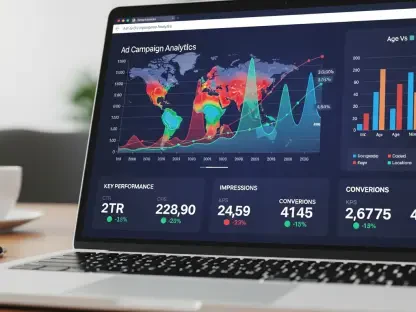Like never before, the rapidly evolving world of marketing is embracing technology to create more meaningful and timely interactions with customers. Among the most transformative tools in this new era is location-based marketing. By harnessing the power of real-time location data, businesses can deliver personalized and context-aware communications, enhancing customer experiences and driving engagement. This article explores how location-based marketing is poised to shape the future of customer engagement.
The Rise of Personalized and Timely Advertising
Enhancing Customer Experience
Location-based marketing thrives on the principle of delivering personalized, timely advertisements tailored to the user’s immediate surroundings. Companies use technologies like geo-fencing, beacon-based marketing, and mobile ads to target consumers more precisely. By sending region-specific offers and alerts about nearby events or stores, businesses can significantly improve the customer experience. Consumers prefer relevant, context-aware notifications, which increase the likelihood of engagement and conversion.
The application of such technologies is widespread, from notifying users about discounts at nearby eateries during lunch hours to alerting customers about flash sales as they walk past shops. This precision in outreach not only enhances the consumer experience but also boosts the efficiency of marketing campaigns. The specificity and timeliness of these messages can lead to higher click-through rates and conversion rates compared to traditional blanket advertising methods. Consequently, businesses can expect increased foot traffic and prompt customer decisions, ultimately translating into higher sales and stronger brand loyalty.
Driving Consumer Behavior
Successful location-based campaigns have illustrated how effective personalized advertising can influence consumer behavior. By focusing on immediate and relevant contexts, businesses can drive consumers’ actions in real time. For instance, restaurants may offer lunchtime discounts for office workers nearby, whereas retail stores can notify customers about in-store deals as they walk past. Such targeted approaches have proven to drive foot traffic and encourage immediate purchases, demonstrating the power of real-time marketing.
Beyond mere notifications, some campaigns integrate interactive elements to deepen engagement. For example, a store might use a scavenger hunt theme, encouraging customers to find and scan QR codes for special discounts, turning shopping into an engaging experience. Furthermore, the data gathered from these interactions provides vital insights into consumer behavior, allowing for even more refined targeting in future campaigns. By leveraging these real-time data points, brands can continually optimize their strategies, thus creating a cycle of improvement that consistently enhances consumer engagement and satisfaction.
Technological Advancements Fueling Growth
Adoption of Data-Driven Strategies
The significant growth of location-based marketing services is closely tied to the adoption of data-driven strategies. Businesses are increasingly leveraging consumer data to create more precise marketing campaigns. By analyzing location data, companies can understand customer preferences and behaviors better, allowing for more effective targeting. This has resulted in higher ROI and more meaningful customer interactions, as accurately delivered advertisements resonate more with their intended audiences.
Moreover, such data-driven approaches provide businesses with the capability to measure the effectiveness of their campaigns in real time. Metrics such as foot traffic changes, purchase behaviors, and engagement rates are analyzed to refine strategies. This constant feedback loop not only optimizes ongoing campaigns but also aids in planning future initiatives. Hence, the integration of data analytics into location-based marketing serves as a cornerstone for driving profitable and lasting consumer relationships. The transition toward these sophisticated strategies indicates a broader industry trend embracing data as a pivotal asset in decision-making processes.
Innovations and Tools
Recent technological innovations are catalyzing the expansion of location-based marketing. The introduction of advanced frameworks like Marketing Data Infrastructure (MDI) by LS Digital has enabled businesses to gain deeper insights from consumer data, thereby driving profitability. Additionally, new tools and integrations, such as the partnership between Peer39 and Basis Technologies, offer advertisers enhanced targeting capabilities without relying on cookies.
These advancements are particularly timely as businesses navigate the shifts away from cookie-based tracking due to increasing privacy concerns and regulations. By deploying alternative technologies that prioritize consumer location data, businesses can maintain high levels of targeting accuracy and personalization. This innovation ecosystem is further enriched by AI and machine learning, which are becoming critical in predicting consumer behavior and preferences. Through continuous learning from location data signals, algorithms can provide even more precise recommendations and insights, thereby pushing the boundaries of what location-based marketing can achieve in terms of customer engagement and satisfaction.
Impact Across Various Industries
Retail and E-commerce
Location-based marketing has demonstrated significant impact in the retail and e-commerce sectors. Retailers utilize location data to inform customers about new arrivals, sales, and exclusive deals in nearby stores. E-commerce businesses can integrate location-based ads to enhance search results and display ads, tailoring their marketing efforts based on the consumer’s current locations. This alignment between marketing efforts and customer location boosts sales and improves customer relationship management.
In practice, this approach manifests in several impactful ways. For example, geo-targeted push notifications can entice nearby shoppers with immediate discounts, encouraging them to visit physical stores. Similarly, digital platforms can use IP addresses to provide location-specific product recommendations, enhancing the shopping experience. Furthermore, the integration of augmented reality in mobile apps allows retailers to offer interactive navigation within stores, further merging online and offline experiences. Consequently, this seamless blending of virtual and physical shopping spaces leads to an enriched customer journey, fostering loyalty and repeat visits.
Travel and Hospitality
The travel and hospitality industry is another beneficiary of location-based marketing. Hotels, resorts, and travel agencies use location data to provide special promotions, upgrade offers, and personalized experiences to guests based on their location. For example, a hotel might send a push notification to guests about dining options within the hotel or nearby attractions, enriching the overall guest experience.
Moreover, travel agencies can use such data to offer personalized tour packages or recommend activities based on the traveler’s location and preferences. This not only enhances the customer experience but also builds a relationship of trust and relevance with the brand. Location-based marketing in this sector can transform mundane stays into memorable experiences by offering contextual and timely recommendations. This approach ensures guests are constantly informed about anything that could enhance their stay—whether it’s an ongoing festival, a local market, or an exclusive hotel event. Such engagements make the guests feel valued and catered to, thereby improving service satisfaction and loyalty.
Competitive Landscape and Market Segmentation
Key Players and Strategic Partnerships
The competitive landscape in the location-based marketing sector is dynamic, with key players like Google, Apple, Microsoft, and HERE Technologies investing in new technologies and forging strategic partnerships. These alliances aim to bolster their market positions and expand their geographic reach. Technological investments and the acquisition of smaller companies are common strategies enabling these industry giants to maintain their competitive edge and innovate continuously.
Strategic partnerships often involve cross-industry collaborations that bring together diverse expertise. For instance, cooperation between tech companies and healthcare providers can lead to advancements in patient engagement and personalized care. Similarly, integrations with social media platforms allow for enhanced targeting and user outreach. By pooling resources and knowledge, these alliances accelerate innovation cycles and enable more sophisticated marketing solutions. This consolidated approach allows companies to tap into broader market segments, drive product innovation, and ultimately secure a competitive advantage in a rapidly evolving landscape.
Market Segmentation
Understanding market segmentation is crucial to grasp the full scope of location-based marketing. The market is segmented by service type—geo-fencing, beacon-based marketing, push notifications, SMS marketing, mobile ads, and social media marketing—each serving distinct advertising needs. Segmentation also distinguishes between small and medium enterprises (SMEs) and large enterprises, reflecting their unique requirements and capacities. This segmentation allows businesses to choose the most suitable strategies to reach their target audience effectively.
The diversity of service types caters to varied business needs. For SMEs, cost-effective solutions like SMS marketing might offer the best return on investment, while large enterprises could benefit more from comprehensive geo-fencing campaigns. Additionally, different industries find unique applications for these services, from transportation and healthcare to media and entertainment. Each segment’s distinct preferences and behaviors necessitate tailored marketing approaches, ensuring that campaigns resonate more deeply with the target demographic. This granular segmentation facilitates a more personalized experience, ultimately leading to higher customer satisfaction and loyalty.
Regional Insights
North America and Europe
North America, particularly the United States, dominates the location-based marketing services market with a commanding share. The region’s robust technological infrastructure and high smartphone penetration support market growth. Europe also shows strong potential, with countries like Germany experiencing significant growth rates driven by increasing adoption of digital marketing strategies and technological innovations. The sophisticated digital ecosystems in these regions allow companies to deploy advanced marketing tools, driving significant consumer engagement and measurable ROI.
Technology-savvy consumers in these markets expect high levels of personalization and real-time engagement. Consequently, businesses are under constant pressure to innovate and improve their location-based marketing efforts. Additionally, regulatory frameworks in these regions emphasize data protection and privacy, necessitating more sophisticated strategies that comply with these laws while still delivering effective marketing. The dynamic interplay of these factors fosters a competitive environment that continually pushes the boundaries of what location-based marketing can achieve. Hence, businesses operating in North America and Europe often serve as innovators, setting benchmarks for the industry worldwide.
Asia-Pacific Expansion
The Asia-Pacific region, led by China, is poised for remarkable growth in location-based marketing. Factors contributing to this expansion include rising smartphone usage, increased internet penetration, and growing consumer confidence in digital interactions. The region presents a vast opportunity for businesses to capitalize on an untapped market and deploy innovative location-based strategies. As urbanization and digital infrastructure improve, location-based marketing stands to become a cornerstone of consumer engagement in these markets.
The diverse and burgeoning population in this region opens up numerous possibilities for personalized marketing. Moreover, the rapid adoption of mobile-first strategies provides a fertile ground for deploying innovative location-based services. Companies can experiment with varied formats such as in-app advertisements, location-based virtual events, and localized content to capture consumer attention. As technological infrastructure continues to mature, the Asia-Pacific market will likely experience an explosion of activity in location-based marketing, presenting both challenges and immense opportunities for businesses looking to establish a foothold in this dynamic environment.
Future Projections and Market Potential
Market Valuation and Growth Forecast
The location-based marketing services market is on a promising trajectory, projected to expand from an estimated value of USD 69.0 billion in 2024 to USD 293.0 billion by 2034. This growth is driven by a robust CAGR of 15.6%, signifying substantial opportunities for businesses to enhance customer engagement through personalized marketing efforts. The impressive projection highlights the market’s capacity for innovation and its critical role in shaping future marketing strategies.
These figures suggest a significant shift in how businesses will approach customer engagement in the coming years. As the market grows, there will be increased investments in technology and data analytics to further refine targeting capabilities. Businesses will focus on harnessing emerging trends such as augmented reality, AI-driven insights, and real-time data analytics to stay ahead. As more companies recognize the value of location-based marketing, competition will likely drive further innovation, making personalized, context-aware engagement the new norm in the marketing landscape. Thus, companies that are slow to adopt these technologies may find themselves at a competitive disadvantage, emphasizing the urgency for early adoption.
Opportunities for Innovation
In today’s rapidly evolving marketing landscape, technology is being embraced like never before to forge more meaningful and timely interactions with customers. A standout tool in this new era is location-based marketing. Leveraging real-time location data, businesses can deliver highly personalized, context-aware communications that enhance the overall customer experience and boost engagement. Imagine walking by a store and getting a notification about a special discount just for you, or receiving an alert when a popular item is back in stock at a nearby location. This isn’t science fiction—it’s the power of location-based marketing at work. By integrating this technology into their strategies, businesses can anticipate customer needs more effectively and offer relevant promotions exactly when they’re most likely to be received positively. This approach not only keeps customers satisfied but also builds loyalty and drives sales. As location-based marketing continues to evolve, it’s poised to significantly shape the future of customer engagement, offering new opportunities for businesses to connect with their audiences in more impactful ways.









